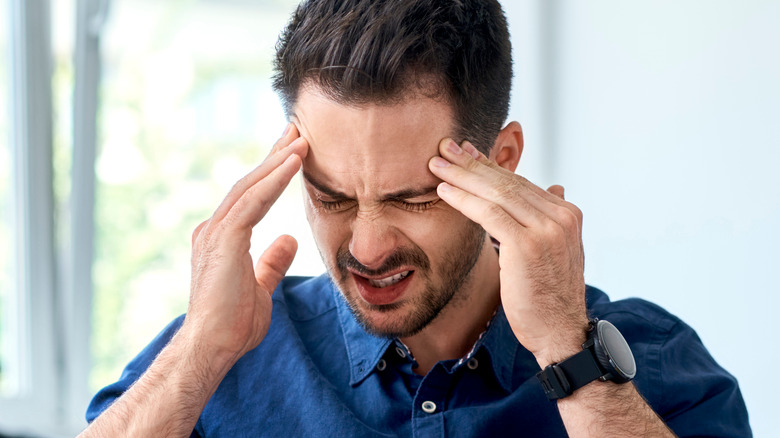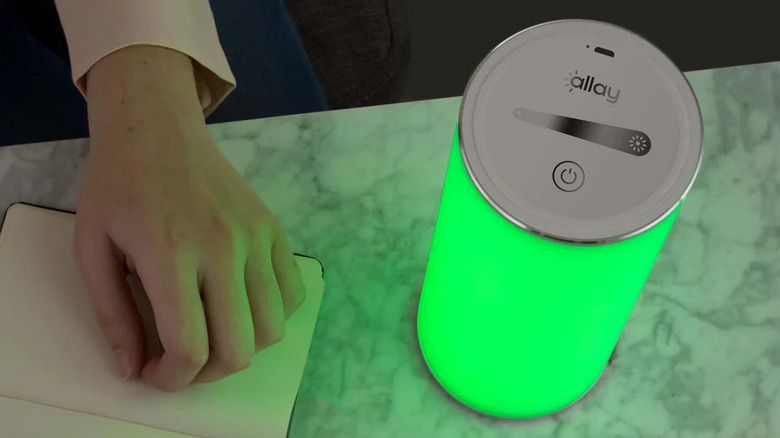5 Products That Make Living With Migraines Easier
We may receive a commission on purchases made from links.
An occasional headache can be a real pain. But while a headache can ruin your day, chronic migraines can disrupt your life (per WebMD). Migraine attacks can be debilitating, making it difficult or impossible to work or perform other everyday tasks, and they are unpredictable in how painful they are and how long they last.
According to the National Headache Foundation (NHF), over 37 million people in the U.S. experience migraines, and up to 80% have family members who also suffer from migraines.
Migraine symptoms include medium to crushing pain, nausea, sensitivity to light and sound, pressure or tenderness in the scalp, sweating, or cold extremities.
Katie M. Golden, a professional writer and advocate for people with chronic pain conditions, tells WebMD she rarely goes a full day without some pain. Her symptoms can escalate to debilitating and in addition to screaming pain, can affect cognitive function, speech, decision-making, and energy level.
Whether you experience moderate or incapacitating migraines, there are things you can do to improve symptoms. Here are five products that make living with migraines easier.
Essential oil
While essential oils won't cure your migraine, peppermint and lavender oils may distract you from some of the symptoms, including pain and nausea. Peppermint has cooling properties that can feel soothing and settle upset stomachs. According to Healthline, applying peppermint essential oil topically may help lessen pain from migraines. Lavender essential oil may also relieve migraine pain. A 2013 study in Evidence-Based Complementary and Alternative Medicine found that after patients suffering from migraine applied two or three drops of lavender essential oil to their upper lip, they reported a significant reduction of pain and other migraine symptoms within 15 minutes after application.
Since becoming available on Amazon in 2019, this $9.99 peppermint-lavender essential oil Migraine Manager roll-on has received nearly 13,000 reviews and is rated 4.5 out of 5 stars.
Green light therapy
Light sensitivity is associated with greater than 80% of migraine attacks. And, according to Harvard Medical School, researchers at the Comprehensive Headache Center at Beth Israel Deaconess Medical Center discovered that the type of light matters to migraine sufferers after finding blue light hurts even blind migraine patients. Alternatively, a 2016 study in Brain found green light therapy reduced light sensitivity and even reduced headache pain during acute migraine attacks in around 20% of patients.
The Allay Lamp retails for $199 (free shipping) and has almost 200 reviews, earning an average of 4.84 out of 5 stars. Sarah of My Migraine Life blog says, "It's another great natural therapy in my migraine toolbox and I use it daily in a variety of ways."
Migraine glasses
It's not just another day at the office when you're experiencing a migraine attack. Bright and buzzy workplace lights can make migraine pain even worse, and AxonOptics says sensitivity to light could trigger a migraine even if you don't already have one. But rose-colored glasses could make life better for migraine sufferers. Migraine glasses are a handy way to block out light when photosensitivity threatens your sanity or your livelihood. You may be tempted to wear ordinary sunglasses in brightly-lit indoor environments, but that could actually make it worse.
Dr. Deborah Friedman, professor of neurology and ophthalmology at the University of Texas Southwestern Medical Center, says, "The retina adapts to being in darkness and makes it difficult to ever emerge into the light" (via Migraine Again). Looking at the blue light from a computer, tablet, TV, or phone screen for long periods can trigger migraines, too.
Try migraine glasses with FL-41 lenses (the rose-colored ones) to filter out irritating light spectrums and protect you from pain. The $99 Classic TheraSpecs have earned 4.3 out of 5 stars with nearly 300 ratings on Amazon.
Heating pad
According to Migraine.com, heat therapy can reduce the severity of migraines. While heat can sometimes bring on a migraine attack for some people, others find that applying heat helps relax tense muscles, improve blood flow, and relieve pain. For instance, a 2021 study in The Journal of the Turkish Study of Algology found that heat reduced migraine intensity in cardiac patients taking nitroglycerine. Unity Point Health suggests using a heating pad or heated rice bag to promote blood flow and help with pain if your migraine is related to reduced blood flow to the brain.
Almost 4,000 reviewers gave the $29.95 Cure Choice heating pad with neck and shoulder padding 4.6 out of 5 stars on Amazon.
For those on the go, the lavender-scented Bed Buddy Aromatherapy Heating Pad gently warms the neck and shoulders and provides the benefits of lavender and rose essential oils for enhanced relief. The 4.4-star-rated heating pad has nearly 5,000 reviews on Amazon and a low price of $11.99.
Ice pack
If applying heat doesn't help your migraine, WebMD says cold therapy may help. Covering the temples and forehead with a cold compress or an ice pack wrapped in a towel would help reduce pain intensity. In a 2006 study published in Evidence-Based Complementary and Alternative Medicine, 28 migraine patients wore a cold gel cap for 25 minutes to treat two different migraines. Two migraine sufferers could not tolerate the cold therapy, but the remaining 26 reported that the cold gel caps reduced migraine severity after 25 minutes.
With more than 18,000 ratings on Amazon, reviewers rate the TheraICE Rx Migraine Relief Hat 4.6 out of 5 stars. The cap costs $34.95, but if it works for you, the relief could be priceless. One reviewer, Sarah Romero, said, "FINALLY! A product that reduces the severity and duration of my migraines." The cooling effect lasts up to 30 minutes, but if your migraines last a long time, you may want to get two.






